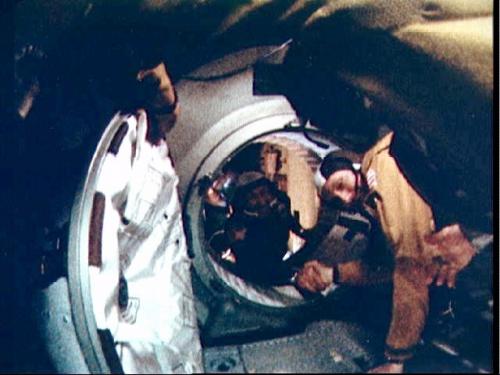

Stories of daring, stories of technological feats, stories of prevailing against the odds ... these are the stories we tell at the National Air and Space Museum. Dive in to the stories below to discover, learn, and be inspired.
Showing 41 - 50 of 54

March 18, 2015
Wednesday, March 18 marks the 50th anniversary of the first extravehicular activity (EVA), or spacewalk, of cosmonaut Aleksei Leonov.

August 01, 2014
What truly captivated me this summer was feeling a personal connection to the history of aviation. I’ve always been interested in the topic, largely because my dad was a Marine Corps fighter pilot. Until this summer I hadn’t had a chance to truly dive into the subject, and finally learning about what my dad did as a pilot has given me a new perspective on his career. He flew F -18s for most of his pilot days, but he also flew F-4 Phantoms, the same plane used for simulator rides here at the museum. I’m sure piloting the simulator isn’t nearly as thrilling (or difficult) as flying a real fighter jet, but it gave me a small taste of my dad’s everyday job. As soon as I hopped out of the ride, I emailed my dad to tell him how exciting my three minutes of pretend-jet-flying had been. He responded by telling me, not for the first time in my life, that he had the “best job in the world.” I never understood the excitement he felt until now.

March 18, 2014
During the 20th century, airplane design was driven by the mantra of “flying faster and higher.”
November 15, 2013
This month marks the twenty-fifth anniversary of the sole launch of the Soviet space shuttle Buran. The idea of a reusable space plane has existed for decades among space enthusiasts and predated the idea of a rocket carrying humans into Earth orbit.

October 20, 2012
Growing up in the Washington, D.C. area during the 1960s was... interesting - History would have a way of occasionally butting into an otherwise typical suburban boyhood.

July 23, 2012
Last week, the Museum recognized the 50th anniversary of Telstar, the first “active” satellite (one that can receive a radio signal from a ground station and then immediately re-transmit it to another) and the first technology of any kind that enabled transatlantic television transmissions. In 1962, both accomplishments generated intense interest, excitement, and commentary.

January 27, 2012
I received a call from Richard Solash, a reporter with Radio Free Europe about ten days ago to discuss a film being made by Slovene director Ziga Virc and writer Bostjan Virc that alleges that Tito's Yugoslavia had a secret space program and secretly sold space knowledge to NASA, in the process making Tito rich and making if possible for the U.S. to achieve its Apollo program.

September 27, 2011
On July 10th, 1962 at 11:47 GMT, the world’s first transmission of a television image by satellite took place, using the Telstar satellite.

July 26, 2010
The Apollo-Soyuz Test Project (ASTP) was the famous “Handshake in Space.” ASTP was the first American-Soviet space flight, docking the last American Apollo spacecraft with the then-Soviet Soyuz spacecraft. This joint effort between the two major world players was based on an agreement signed in 1972, and it set a precedent for future joint efforts, such as the Shuttle-Mir Program and the International Space Station.

June 11, 2010
10 Cool Things You May Not Know About The Museum's Lockheed SR-71 Blackbird